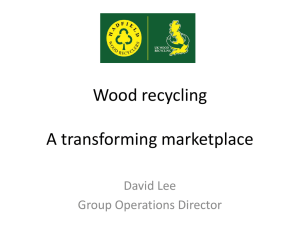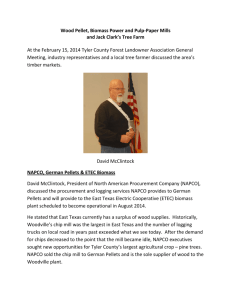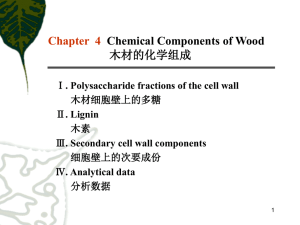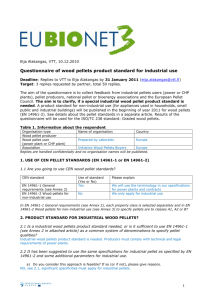Bioenergy - WOOD 120
advertisement
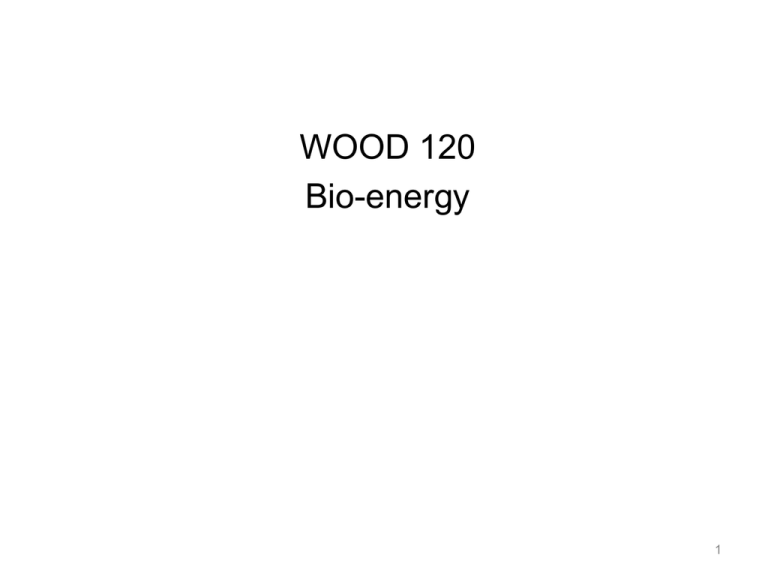
WOOD 120 Bio-energy 1 The “Bio-Buzzwords” • Bio-energy • Bio-mass • Bio-fuels • Bio-diesel 2 Past practice in BC Beehive burners Sawmill waste (hog fuel) was burned without capturing heat value. Now sawmill waste is burned to heat the dry kilns. 3 Forms of Energy • Electricity • Transportation fuel • Heat 4 Forms of Energy • Solid • Liquid • Gas Fossil fuels (the simple slide) CO2 Fossil Fuels 6 Bioenergy (the simple slide) CO2 Biomass Fossil Fuels reduce 7 Bioenergy (the more complicated slide) 8 Bioenergy – drivers • Climate change • Shortages of traditional energy sources • Costs of traditional energy sources • Energy security • Landfill reduction • Mountain Pine Beetle (BC-specific) 9 Biomass – sources • Grain • Straw • Grass • Sugar cane (bagasse) • Wood (lignocellulose) 10 Wood vs. other cellulosic biomasses • Longer storage life and lower storage costs • Higher bulk density • Less intensive use of water and fertilizer in its growth • Established collection system exists 11 Transportation 12 GJ per unit Energy density of materials 13 Bioenergy – technology platforms • • • • Wood pellets Gasification Bio-ethanol Direct combustion 14 Bio-fuel status in BC www.energyplan.gov.bc.ca 15 Wood Pellets • Sawmill waste extruded into small pellets. • Either burned directly for heat value or for generation of electricity • Used domestically (N.A.) and industrially (Europe) 16 Wood Pellets • Waste may be ground to consistent, fine size. • Pressed through pelletizer to consolidate. • Pellets are held together by natural “adhesive” in wood (lignin). • Pellets are denser than starting material. 17 Wood Pellet Stove 1 – Hopper 2 – Convection fan 3 – Auger 4 – Ash pan 5 – Igniter 6 – Heat exchange tubes 7 – Burn chamber www.pelprostoves.com/images/pelpro-cutaway.jpg 18 Pellet plants in BC (2011) • 8 plants • 787,000 tonnes production • Plant capacity 56-186,000 tonnes • Used 2.2 million m3 of wood residues • 10% of global market Liquid biofuels • Bio-ethanol (one example) • Currently produced from grain (in NA) • Blended with gasoline • Gasoline:ethanol 90:10 • Reduces carbon monoxide emissions 20 Wood Chemistry WOOD Holocellulose Cellulose Lignin(s) Extractives Ash Hemicellulose(s) 21 Bioethanol from wood waste Burn Solid material Wood Enzymes Solid residue New products? Pretreatment Sugars in solution Fermentation Alcohol 22 Comparsion of bio-fuel feedstocks 23 Conversion of biomass sources LIGNOCELLULOSE Pretreatment Fractionation Fractionation Fractionation Enzymatic Hydrolysis Enzymatic Hydrolysis Hexoses Hexoses Hemicellulose Pretreatment Cellulose Pretreatment Hexoses Pentoses Fermentation Fermentation Fermentation Recovery Recovery Recovery BIOFUELS BIOENERGY BIOPRODUCTS Extractives STARCH Lignin SUGAR Bio-ethanol from wood • Wood is hard to break down into chemical components • High cost of enzymes • Products need to be developed utilizing solid residue (lignin) • Rate of development of technology is influenced by price of oil 25 Gasification • Burns biomass with controlled amount of oxygen • Converts biomass into carbon monoxide and hydrogen • Results in “syngas” which is itself a fuel www.nexterra.ca/i_mages2/Gasifier.jpg 26 Gasification • Cleaner and more efficient technology than direct conversion of biomass • Syngas can be burned on site (for production of electricity) or transported (increase in energy density) http://www.sc.edu/usctimes/articles/2005-02/images/gasification.jpg 27 Gasification plant at UBC • Opened in September 2012 • 25,000 tonnes of urban wood waste per year from Metro Vancouver • Generation of steam and electricity • Low pressure steam (15% reduction of natural gas used for heating on UBC campus) • Electricity generation (2MW, demonstration scale) • GHG reduction of 5,000 tonnes/year* 28 Gasification plant at UBC Photo credits: Don Erhardt 29 Gasification plant at UBC (Nexterra) 30 Electricity generation Raw material ? 31 Cogeneration plant • • • • William’s Lake, BC Established in 1993 60 MW capacity Electricity feeds into BC Hydro grid • Burns wood waste (600,000 tonnes/year) • 4-5 local sawmills provide wood waste (combined capacity of 1 billion fbm) • High efficiency combustion 32 Looking back and forward…?? log (primary energy use) by category Hydrocarbon economy Biomass & renewables 2020 2000 1980 1940 Oil & Gas 1920 1900 1860 1820 1780 1740 1700 Coal 2100 Industrial revolution 2080 Agricultural-based 1990-21?? 2060 1800-2050 2040 ??-1800 Carbohydrate economy 1960 Carbohydrate economy Current Status of Bio-Energy Technologies Gasification 34 Bio-energy - issues • Government policies (e.g., tax credits? R&D incentives?) • Competing green technologies (e.g., wind, wave, geothermal) • Competing bio-energy technology platforms still being developed • Competing new fosil fuel capcaity in North America • Food vs. Fuel vs. Fibre


